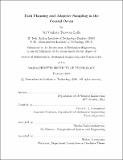| dc.contributor.advisor | Pierre F. J. Lermusiaux. | en_US |
| dc.contributor.author | Lolla, Sri Venkata Tapovan | en_US |
| dc.contributor.other | Massachusetts Institute of Technology. Department of Mechanical Engineering. | en_US |
| dc.date.accessioned | 2016-07-01T18:24:09Z | |
| dc.date.available | 2016-07-01T18:24:09Z | |
| dc.date.copyright | 2016 | en_US |
| dc.date.issued | 2016 | en_US |
| dc.identifier.uri | http://hdl.handle.net/1721.1/103438 | |
| dc.description | Thesis: Ph. D. in Mechanical Engineering and Computation, Massachusetts Institute of Technology, Department of Mechanical Engineering, 2016. | en_US |
| dc.description | This electronic version was submitted by the student author. The certified thesis is available in the Institute Archives and Special Collections. | en_US |
| dc.description | Cataloged from student-submitted PDF version of thesis. | en_US |
| dc.description | Includes bibliographical references (pages 299-315). | en_US |
| dc.description.abstract | When humans or robots operate in complex dynamic environments, the planning of paths and the collection of observations are basic, indispensable problems. In the oceanic and atmospheric environments, the concurrent use of multiple mobile sensing platforms in unmanned missions is growing very rapidly. Opportunities for a paradigm shift in the science of autonomy involve the development of fundamental theories to optimally collect information, learn, collaborate and make decisions under uncertainty while persistently adapting to and utilizing the dynamic environment. To address such pressing needs, this thesis derives governing equations and develops rigorous methodologies for optimal path planning and optimal sampling using collaborative swarms of autonomous mobile platforms. The application focus is the coastal ocean where currents can be much larger than platform speeds, but the fundamental results also apply to other dynamic environments. We first undertake a theoretical synthesis of minimum-time control of vehicles operating in general dynamic flows. Using various ideas rooted in non-smooth calculus, we prove that an unsteady Hamilton-Jacobi equation governs the forward reachable sets in any type of Lipschitz-continuous flow. Next, we show that with a suitable modification to the Hamiltonian, the results can be rigorously generalized to perform time-optimal path planning with anisotropic motion constraints and with moving obstacles and unsafe 'forbidden' regions. We then derive a level-set methodology for distance-based coordination of swarms of vehicles operating in minimum time within strong and dynamic ocean currents. The results are illustrated for varied fluid and ocean flow simulations. Finally, the new path planning system is applied to swarms of vehicles operating in the complex geometry of the Philippine Archipelago, utilizing realistic multi-scale current predictions from a data-assimilative ocean modeling system. In the second part of the thesis, we derive a theory for adaptive sampling that exploits the governing nonlinear dynamics of the system and captures the non-Gaussian structure of the random state fields. Optimal observation locations are determined by maximizing the mutual information between the candidate observations and the variables of interest. We develop a novel Bayesian smoother for high-dimensional continuous stochastic fields governed by general nonlinear dynamics. This smoother combines the adaptive reduced-order Dynamically-Orthogonal equations with Gaussian Mixture Models, extending linearized Gaussian backward pass updates to a nonlinear, non-Gaussian setting. The Bayesian information transfer, both forward and backward in time, is efficiently carried out in the evolving dominant stochastic subspace. Building on the foundations of the smoother, we then derive an efficient technique to quantify the spatially and temporally varying mutual information field in general nonlinear dynamical systems. The globally optimal sequence of future sampling locations is rigorously determined by a novel dynamic programming approach that combines this computation of mutual information fields with the predictions of the forward reachable set. All the results are exemplified and their performance is quantitatively assessed using a variety of simulated fluid and ocean flows. The above novel theories and schemes are integrated so as to provide real-time computational intelligence for collaborative swarms of autonomous sensing vehicles. The integrated system guides groups of vehicles along predicted optimal trajectories and continuously improves field estimates as the observations predicted to be most informative are collected and assimilated. The optimal sampling locations and optimal trajectories are continuously forecast, all in an autonomous and coordinated fashion. | en_US |
| dc.description.statementofresponsibility | by Sri Venkata Tapovan Lolla. | en_US |
| dc.format.extent | 315 pages | en_US |
| dc.language.iso | eng | en_US |
| dc.publisher | Massachusetts Institute of Technology | en_US |
| dc.rights | M.I.T. theses are protected by copyright. They may be viewed from this source for any purpose, but reproduction or distribution in any format is prohibited without written permission. See provided URL for inquiries about permission. | en_US |
| dc.rights.uri | http://dspace.mit.edu/handle/1721.1/7582 | en_US |
| dc.subject | Mechanical Engineering. | en_US |
| dc.title | Path planning and adaptive sampling in the coastal ocean | en_US |
| dc.type | Thesis | en_US |
| dc.description.degree | Ph. D. in Mechanical Engineering and Computation | en_US |
| dc.contributor.department | Massachusetts Institute of Technology. Department of Mechanical Engineering | |
| dc.identifier.oclc | 952424944 | en_US |
